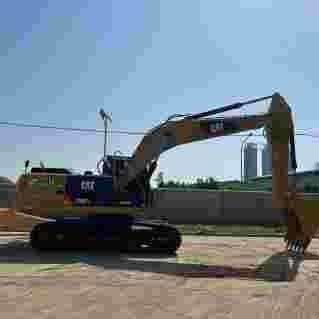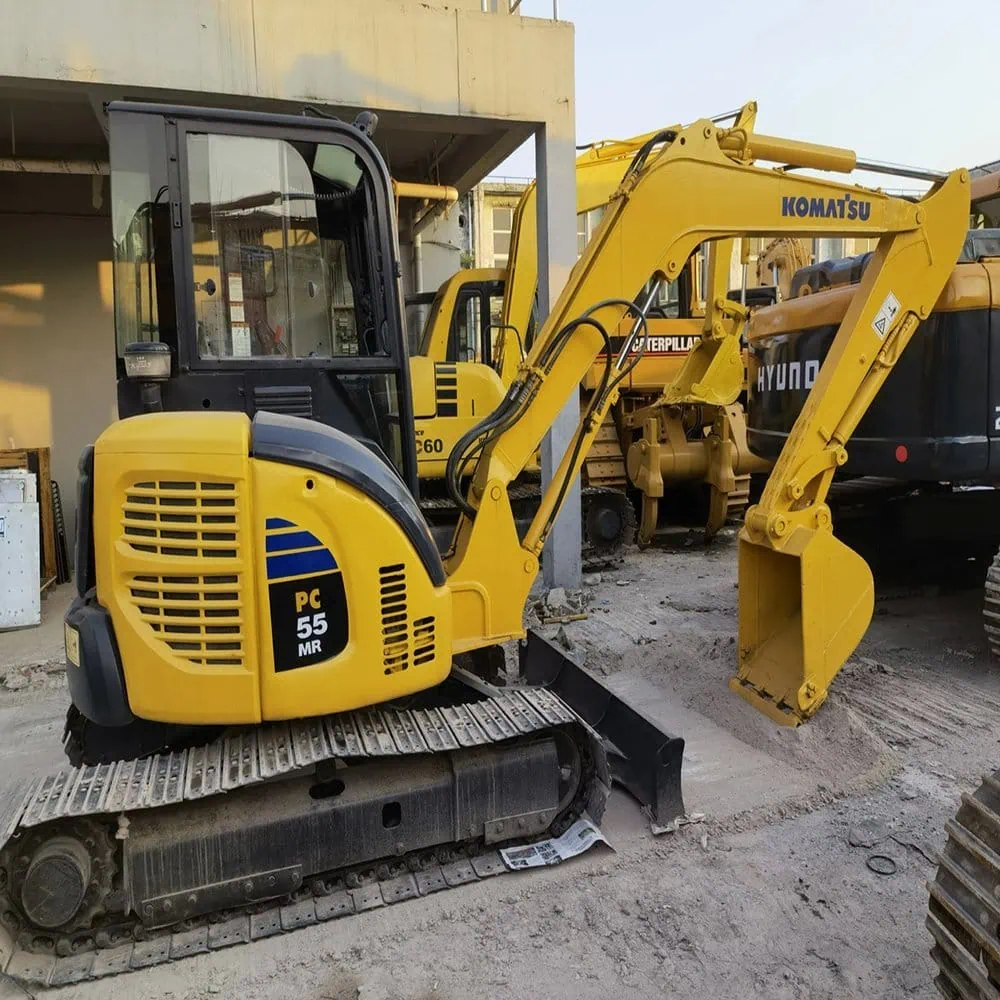Having a problem dealing with those complicated benching excavations in tight spots? Digging deep trenches can be a tough job and dangerous if you don’t know how to do it correctly. If not done properly, loose soil can easily collapse and kill you. But the good news is, if you understand how benching excavations work, you can move mountains of earth safely and quickly.
Benching excavation is a key safety measure used in construction to prevent cave-ins during deep trenching. By cutting back the walls of the excavation into steps or “benches,” workers can safely access the site while maintaining stability. Whether you’re dealing with clay, sand, or gravel, understanding the proper benching requirements for your excavation can save time and prevent costly accidents.
Now that you understand the basics of benching excavation, let’s dive into how it works and the key factors to consider.

جدول المحتويات
تبديلWhat is Benching in Excavation?
What Does Benching Mean in Excavation?
Benching excavation is where you cut the trench or hole back in a series of steps or benches. Every so often, you cut the sides of the trench away to create a horizontal step. These steps spread out the weight of the soil and stop it from caving in on you. You use this method when you’re digging a deep hole or trench where the soil on the sides could cave in on you and crush you to death.
The whole idea of benching excavation is to provide security and safety for the people who are digging by keeping the ground behind them from coming in on top of them. That’s why it’s called “benching.” You’re creating a series of horizontal benches or platforms as you dig your excavation.
What is Benching in Excavation?
The way benching excavation works is you cut the walls of the excavation back at intervals to create a horizontal step. The width and depth of these intervals depend upon the size of excavation and the type of soil you’re dealing with. Every time you cut a step or “bench,” it acts as a form of backstop to keep the ground from falling in on your head.
The number of benches you cut into the banks of your excavation are based upon how deep you are going. In general, figure on one to two benches for every 10 feet. You cut them at about a 30- to 45-degree angle to keep it safe for your people and your machines to work in the hole.
How Does Benching Work in Excavation?
What is Benching in Excavation?
Establishing safe means and methods to work around these remnant relics of history is one of the fastest growing areas of our business. I opened another company this year specializing in remote inspection and detection of potential harm to construction workers. So this is a field that is not only growing, it is becoming more important every day. And it starts with understanding the basics of benching for safety on the job site.
Each of your benching excavation steps has an angle, width, and depth specifically designed to be your best trade-off between safety and getting the job done. The deeper the hole, the more benches you will be cutting and the size of your steps will adjust accordingly to suit the depth and the type of soil in which you find yourself digging.
Where we use the benching excavation method, in practice, is trenching, foundation work, and in anything which involves truly deep digging or excavation. This process is frequently used in large-scale, civil engineering, dirt-moving projects such as building roads and infrastructure. Once an excavator gets about 10 feet deeper than they can reach across, they start using a trench box. The angle of each bench required can range anywhere from 30 to 45 degrees, depending on the soil type and the depth of the excavation. The key is to make it safe for your people to work there, and for the excavation to remain structurally stable while you get your work done.

How Does the Benching Process Ensure Stability?
Why would I be benching excavation? Why don’t I just keep digging down and make it a big walled vertical hole? You bench the sides in order to take the pressure off the soil. Once you dig it so deep, the weight of the surrounding soil doesn’t work in your favor. The goal is to make those gigantically heavy walls of earth work for you and not against you. So, by benching the excavation, you distribute the weight of the earth more evenly. In doing so, you take away the chance that a whole lot of dirt could move at one time and crush you in your excavation.
Efficiently and safely execute your benching excavation by understanding the basic concepts. While you dig your hole, and depend on where you are and who you are, you will find the benching helps get you the dirt more safely. as well. The Benefits of Benching Excavation: You chip the walls back to get your hole, but why are you benching the hole? You bench your hole to keep it from caving in on you as you dig.
In certain situations, an engineer may determine open trench excavation is the best option to safely reach the desired depth to install a utility line. If the trench is deeper than 20 feet, the goal is to have stable soil insuring it stays on the sidewalls and won’t slump into the excavation before utility line installation.

What is the Correct Benching Slope for Excavations?
What is Benching Slope and How Does it Affect Excavation?
Benching excavations are sloped so that whenever you cut back a bench, you remove enough material to form a slope that will hold until you finish the work. If the slope is not suitable, the bank will collapse and likely throw soil onto the last bench, burying the people working there. So, the slope is important. In your excavation, you need to figure out the best slope for the type of material you are working with.
The ideal benching slope will vary based on several factors, including:
- نوع التربة: Stable, granular soils like sand or gravel allow for steeper slopes, whereas clay or loose soil may require gentler slopes to reduce the risk of collapse.
- Excavation Depth: The deeper the excavation, the more gradual the slope should be. A steeper slope in deep excavations increases the likelihood of a cave-in due to the weight and pressure from the upper layers of soil.
- Moisture Content: Wet soil is more likely to shift and collapse, which requires a gentler slope to maintain stability.
But in general, if the existing soil in your excavation will hold a slope at all, make your slope between 30 and 45 degrees. However, in certain situations where the hole is deeper or the soil isn’t as stable, you may need to have a slope less than 30 degrees, which means your benches will be wider and your steps shorter.
How to Adjust the Benching Slope Based on Soil Conditions?
When you’re benching an excavation, soil type and conditions typically determine what slope will hold. For instance, if you’re excavating a hole in some super loose or super saturated soil, most likely you’re not going
to hold this slope at all. You may need a gentler slope. As a result, you make your benches wider—you don’t have your 45-degree slope—and you cut your steps shorter.
On the other hand, if the soil is stable and well compacted, you can probably hold a steeper angle. You’ll have fewer benches, and your overall hole will require fewer benches, which will save you time digging. For either
type of soil, the bottom line is make the slope safe based on what your dirt will do. Keep the dirt in the hole, keep the hole moving forward like it’s supposed to, and keep everybody on your project happy and working.
What Are the Key Benching Requirements for Excavations?
Safety standards for benching excavation are determined by local laws and industry standards. These laws and standards tell you how to design it, what your allowable angles are, and how high each bench can be to keep from killing somebody. In the United States, OSHA keeps us in check with what we can and cannot do when it comes to trench and excavation safety, which is exactly what a benching excavation is.
According to OSHA and their regulations, the height of the bench can be no more than five feet deep if the soil is loose or not very stable. The excavation itself can be no deeper than a total of 12 feet. The actual width of the bench that you carve out of the dirt is deep enough so you can safely get onto the next step, which might be two to four feet. It all depends on how deep and the type of soil you’re digging into.
By following these guidelines, you’ll keep your people safe, and that’s what we’re trying to do. We want you to go home to your family at the end of the day.
What Is the Maximum Height for Benching Excavation?
Benching the maximum height is so important because the deeper you get, the more trouble you’re in a lot of times. When you get down there like you do in foundation work or you’ve got some deep trenching, just the pure weight of the dirt can make it collapse.
Failure to control and limit the height of the benching will cause a cave-in. The maximum height of a bench in a benching excavation is usually about 5 feet. When you have a deeper excavation, keep the bench height lower and the number of benches more frequent. Going much more height than this is hazardous because the dirt is generally very loose and improperly compacted in these types of excavations. The Occupational Safety and Health Administration (OSHA) has a requirement that if you dig a trench deeper than 5 feet deep that you have to have it properly shored up or benched.
Depending on the type of soil you are in will depend on how high you can go. For sandy or wet soil, the bench height may need to be smaller. To figure the height of the benches, manufacturers will take this into consideration during the design phase and especially during soil testing. If possible, you should check the plans and dig to the sizes for the specs.

How to Choose the Right Excavator for Benching Excavation?
أيّ حفارة is Best for Benching Excavation?
What excavator works best? It depends on your situation, the depth of the trench you are in, the soil and, of course, your project’s size. You need an excavator that has enough lift and reach to accuratly cut the benches and keep the exposure as you cut your benches. This is how you get your benches straight, and make the hole you are in as safe as possible.
For smaller to medium-sized excavations, a compact excavator may be suitable for creating shallow benches and working in confined spaces. However, for deeper benching excavations, a larger, more powerful machine such as a crawler excavator or hydraulic excavator is necessary to ensure that the machine can handle the weight of the soil and efficiently cut back the excavation walls.
What Features Should Excavators Have for Benching Excavation?
When selecting an excavator for benching excavation, consider features like:
- Longer Reach: For deep excavations, the excavator should have a long arm reach to safely access and cut the bench.
- High Lifting Capacity: Excavators with higher lifting capacities are necessary for handling large volumes of soil during the benching process.
- Rotary or Hydraulic Attachments: Hydraulic attachments like tiltrotators can be extremely useful in ensuring precise cuts during benching excavation.
They do make different sizes and types of حفارات. Brands like Caterpillar and Komatsu offer specialty machines for just this type of work. They are powerhouses, as far as work can go, and they have all the little add-on features you need to jack up a piece of pipe or protect yourself while digging that trench. These are wonder machines if you can get one specific for your project.
What Are the Safety Considerations for Benching Excavation?
How to Ensure Safe Benching Excavation Practices?
Ensuring safety during benching excavation requires several precautionary measures:
- Proper Training: Just like with backhoe operators, you have to be a knowledgeable, well-trained professional to work with this type of equipment. You have to be good with the act of excavating and understand the inherent safety that goes with it.
- Soil Monitoring: Throughout the excavation, you depend on the stability of those benches you’ve cut. You also need to monitor the soil to help with bench stability. You should always expect the soil to give way because it’s nature’s way to come down on you whatever you are digging.
- Protective Equipment: Always wear your hard hat, boots, and reflective vest when operating around or in a trench.
By following the rules and using what you are supposed to use, you will cut down on the accidents when working with benching on an excavation.
What Are the Common Risks in Benching Excavation?
Common risks associated with benching excavation include cave-ins, falling debris, and equipment malfunctions. To mitigate these risks, proper shoring or bracing is often necessary, particularly for deeper excavations. Regular safety checks and hazard assessments can also help ensure a safer work environment.

Can Benching Excavation Be Used in All Soil Types?
Benching excavations can also be particularly difficult in areas with rocky soil, as the intended benches can break or shatter during excavation or backfilling. The risk of a cave-in in rocky soil is generally much lower than in sandy or clay soil. Organic soil, like peat or topsoil, can also be challenging to bench due to the way it expands under stress. These soils can be especially difficult to handle as the walks collapse and fill in the ditch.
- Dry, Stable Soil: Easier to bench with steeper slopes.
- Loose or Wet Soil: Requires gentler slopes and more frequent benching to ensure stability.
Typically, soil conditions must be tested to see what type of angle and how deep the benches need to be for a proper benching excavation. If the soil is not stable, you might need additional shoring or support system to hold it up.
What Are the Costs Associated with Benching Excavation?
The costs of using benching excavation include renting or buying an excavator, the cost of labor, and any extra safety equipment or material needed for shoring and bracing. It is very cost-effective, mainly versus sheeting, and more costly than open cut. The machinery and training necessary to do the job correctly should be considered as higher costs in the macro of the job. But these are the costs necessary to do a job safely and have fewer accidents, which will cause delays and added costs.
خاتمة
Benching excavation is an important practice in the industry, and it is an excellent way to be safe when you have to dig a deep excavation. If you understand what you are doing, follow the rules and safety standards, and have the equipment, you can do these jobs safely, on time, and under budget.
The key to benching excavation is knowing your soil and if you need to use it. You need to understand what kind of equipment to use. You need to know how to do it right. You need to make sure everything is safe so that your people can go home at night.Our company HIXEN specializes in all kinds of second-hand construction machinery. If you have any questions, please feel free to اتصل بي. I hope I can help you with your project.










